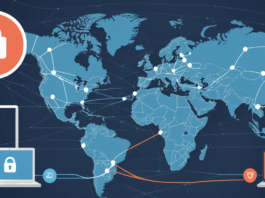Understanding CVE-2024-21320: The Initial Spoofing Vulnerability
CVE-2024-21320 emerged as a notable security concern, marking a significant spoofing vulnerability that affects multiple versions of the Windows operating system, specifically from versions 7 through 11. This vulnerability was initially discovered by Akamai researcher Tomer Peled and highlights critical implications for the security of Windows systems globally. Spoofing vulnerabilities generally enable an attacker to impersonate a legitimate user or system, leading to unauthorized access and potentially severe consequences.
The mechanics behind CVE-2024-21320 involve the exploitation of theme files, which are utilized in customizing the user interface in Windows. Attackers can manipulate these theme files to trick the operating system into processing malicious data. Consequently, this may expose NTLM (NT LAN Manager) authentication information, which is crucial for network security and user credential verification. The fact that such a vulnerability can be amplified through common user interface components underscores the severity of the threat, as many users may unwittingly expose themselves to attacks simply by changing their themes.
The implications of this vulnerability extend beyond immediate access to user credentials. If attackers are able to exploit the theme files successfully, they may conduct further lateral movements within a network, increasing their foothold and potentially accessing sensitive data. This could lead to severe breaches, including but not limited to, data theft, unauthorized modifications within systems, and cascading impacts on network integrity.
Users and organizations running any affected version of Windows must remain vigilant regarding security updates while implementing best practices for security hygiene. Understanding CVE-2024-21320 is crucial for preventing escalation into broader security incidents stemming from credential theft and the subsequent compromise of sensitive systems
Microsoft’s Response: The Patch and Its Flaws
In January 2024, Microsoft took steps to address the vulnerability identified as CVE-2024-21320 by releasing a patch aimed at mitigating the risks associated with the exploit. The approach utilized a specific function known as ‘patchisunc,’ which was designed to assist in remedying the vulnerability by ensuring that the affected systems were properly updated. This initial response was anticipated to strengthen the security posture of various applications and prevent potential breaches that could arise from the identified flaw.
However, the aftermath of this patch proved to be contentious. Subsequent assessments revealed that, rather than effectively sealing the original vulnerability, the implementation of the patch inadvertently generated its own set of issues. This evaluation was notably conducted by researcher Peled, who found that the patch did not adequately address CVE-2024-21320. Instead, it led to the formation of a new vulnerability, designated as CVE-2024-38030. The emergence of this additional flaw raised alarm bells within the cybersecurity community, as it highlighted a critical oversight in Microsoft’s patch management approach.
The situation underscores the complexities involved in cybersecurity measures, particularly when dealing with existing vulnerabilities. It illustrates how a quick fix can sometimes escalate rather than resolve security challenges. Peled’s findings serve as a stark reminder of the necessity for robust and comprehensive security measures in software development. The incident emphasizes that thorough testing and validation processes are essential prior to the deployment of any patches, ensuring that they do not introduce further vulnerabilities but genuinely improve the overall security infrastructure. Therefore, Microsoft’s experience with this patch serves as a cautionary tale regarding the importance of vigilance in cybersecurity practices.
Interim Solutions: Acros Security’s Micropatch
As cybersecurity threats continue to evolve, the inadequacy of Microsoft’s patch for CVE-2024-21320 has prompted the need for interim solutions. Acros Security has stepped in to address this critical need by developing an innovative micropatch specifically designed to resolve the vulnerabilities that have surfaced in Windows theme files. This micropatch offers users a timely and effective workaround while Microsoft works towards a permanent solution.
Acros Security’s approach is notable as it recognizes the urgent requirement for protective measures amidst the escalating risk of exploitation. The company identified the vulnerability soon after the flawed Microsoft patch was released, showcasing their commitment to proactive security measures. The ability to rapidly assess emerging threats allows Acros to provide an immediate response, safeguarding users from potential attacks that could exploit the identified weaknesses.
To ensure widespread availability and ease of deployment, Acros utilizes the 0patch agent, a lightweight tool designed to apply micropatches with minimal disruption to users’ systems. This agent allows for real-time distribution and implementation of the necessary patches, enabling users to maintain optimal security without overhauling their existing software or system configurations. Such a solution is particularly important during a security emergency, where every moment counts in mitigating potential damage.
Acros Security’s micropatch exemplifies the critical role that third-party solutions can play in a collaborative defense against cyber threats. By addressing vulnerabilities promptly, they empower users to navigate the complex landscape of cybersecurity with greater confidence while awaiting a comprehensive fix from Microsoft. In light of ongoing threats, the efficacy of such interim solutions underscores their importance in maintaining system integrity and operational continuity.
Future Implications: The Importance of Rigorous Security Practices
The discovery of vulnerabilities such as CVE-2024-21320 highlights the pressing need for organizations and users employing Microsoft Windows to adopt rigorous security practices. The ineffectiveness of patches to address such vulnerabilities raises significant concerns regarding the overall security posture of affected systems. As cyber threats evolve, so must the strategies employed to safeguard sensitive information. Regular updates are a cornerstone of these security practices, ensuring that systems are equipped to counter newly identified threats. However, the experience with recent patches indicates that relying solely on vendor updates may not suffice.
Continuous monitoring for vulnerabilities should complement the update process. Organizations should implement strategies that allow them to identify potential weaknesses within their systems promptly. This proactive approach enables timely remediation of vulnerabilities before they can be exploited. Furthermore, integrating third-party security solutions offers additional layers of defense. For instance, security firms like Acros Security play a crucial role in providing timely solutions and expert knowledge, helping organizations maintain a robust security framework. Collaborating with such entities fosters a proactive security culture, encouraging users and organizations to remain vigilant against emerging threats.
To effectively safeguard sensitive information against future vulnerabilities, organizations should adhere to best practices. These practices include performing regular security assessments, conducting employee training sessions to raise awareness of cybersecurity risks, and investing in comprehensive security solutions. Additionally, establishing an incident response strategy allows organizations to act swiftly in the event of a security breach. In conclusion, fostering a security-conscious environment coupled with the adoption of rigorous practices is essential for mitigating the risks associated with emerging vulnerabilities. By doing so, organizations can better protect themselves and their users in an increasingly complex cyber landscape.




